Finally, an online tee-time booking system for tons of great golf courses across Ireland and the UK! Brought to you by the good folks at BRS Golf.
In the past I have been hesitant about using online booking systems run by many of the golf clubs across Ireland, Scotland, and England. Why? Well, let’s just say their speciality has been in running and maintaining golf courses and not online web-based tee time systems. I was always worried my reservation would go into a black hole and I’d show up at the club and be greeted by blank stares followed by, “Sorry Mr. Babcock, we have never heard of you and we’re fully booked today.” That would be a disaster.
BRS Golf to the rescue! They run a very useful and practical online tee-time booking system utilized by over 110 courses in Ireland and 90 courses in the UK (and growing!). For example, Carne Golf Links uses the BRS Golf system for their online booking. When you enter the system you see available tee time slots on a month by month basis and then can drill down to a particular day and pick specific times for 1, 2, 3, or 4 golfers — and see the green fee rate.
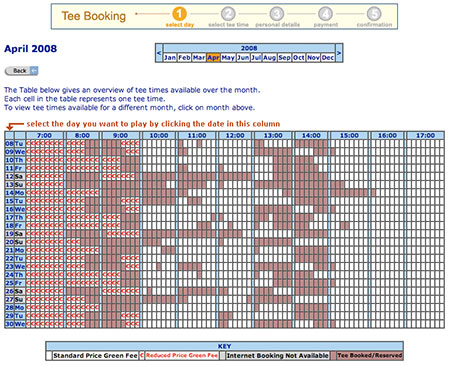
At North and West Coast Links Ireland you can use the BRS Golf system to book tee times at six different courses (Ardglass, Ballyliffen, Carne, Connemara, County Sligo, Enniscrone, and Rosapenna) in one fell swoop.
So, if you’re booking your Ireland or Scotland Golf Adventure tee times online be sure to look for “brsgolf.com” in the URL. If you see that, you know your tee time booking experience will be a successful one.
Here’s an example of using the Ireland Golf Adventure Guide to plan a golf trip for four golfers.
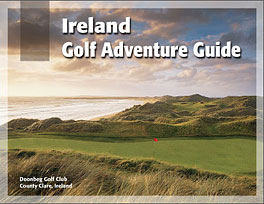 The Scenario
The Scenario
Four golfers from New York want to enjoy five days of golf in Ireland this summer.
Using the Ireland Golf Adventure Guide
Here’s how a user of the guide might plan such a trip. The text below is basically describing the thought process and the use of the guide, while working through the trip-planning steps (p. 2) then making reservations and tee times. In this fictitious example, the trip planner is basically thinking out loud. Let’s go!
Buy the Collins Visitors Map Ireland (p. 3). I won’t need the map while planning this simple itinerary, but I’ll want it in Ireland to help navigate the Irish roads. From the PDF version of the guide, I can click on the picture of the map (or its ISBN number) and it takes me right to the web page on Amazon.com where I can buy it. Very convenient.
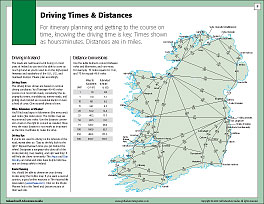 Start building the rough itinerary (p. 6). We only have five days, so I want to minimize driving. Looking at the Driving Times & Distances map (p. 8) and Golf Courses & Towns Map (p. 9) I see that the southwest area is good. The Getting to Ireland section (pp. 18-19 are relevant to travellers from the U.S.) recommends flying into Shannon. I’ll figure out where to stay later.
Start building the rough itinerary (p. 6). We only have five days, so I want to minimize driving. Looking at the Driving Times & Distances map (p. 8) and Golf Courses & Towns Map (p. 9) I see that the southwest area is good. The Getting to Ireland section (pp. 18-19 are relevant to travellers from the U.S.) recommends flying into Shannon. I’ll figure out where to stay later.
Make a list of courses (pp. 7-17). I see that possible courses in this area are: Tralee, Dingle, Dooks, Killarney, Waterville, Ballybunion Old, Doonbeg, Lahinch Old, Old Head, Dromoland, and Adare. That’s enough; we only have five days.
Fine tune the course list. Having previously read about Tralee, Ballybunion, Doonbeg, and Lahinch, those go to the top of my wish list. I need one more course. Since we’re playing Tralee, let’s stay in Tralee after we arrive (p. 28). Old Head is quite a drive, so that’s out. Waterville is a good course, but not that close. I decide against Dromoland and Adare; we want another links course. That leaves Dooks and Dingle. I check out their relative ranking (p. 16) and Dingle comes out ahead. I see that Eddie Hackett did some design work in 1972. I look up Hackett in the Golf Course Designer index (p. 17) and see the other courses he designed. I’m impressed and decide to play Dingle. Our five courses are: Ballybunion Old, Dingle, Doonbeg, Lahinch, Tralee. But that’s just a list, not an itinerary. I need to put them in playing order.
Arrange the courses in sequence (p. 6). Since we’re staying in Tralee, it might be nice to play Tralee the first day so we don’t have to rush in the morning. The Itinerary Tips (p. 6) and Choosing Where to Stay (p. 23) lead me to decide on playing Ballybunion on the way to Lahinch (due to the change of accommodation). That means we should play Dingle on day 2. Ballybunion lands on day 3, and Lahinch and Doonbeg are pretty much interchangeable as the last two days.
Pick when to go. In the When to Go section (page 4) I see the weather is good in June and the golf courses less crowded than in July or August. Lets go in June. I check out the average rainfall and temperature graphic (p. 5) and June looks like a good choice.
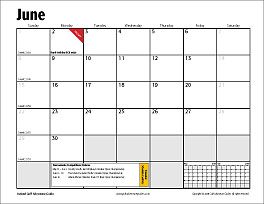 Transfer to the calendar (p. 6) Using the Course Cards (card_irl200x.pdf), I see that the only course in this list with visitor-policy issues is Tralee. Looking at the detailed visitor policy (p. 15) for Tralee confirms it–no visitors Sunday (all year) or Wednesday (June, July, August). That means we could play our first round in Tralee on a Monday. Looking at the calendar (calendar_irl2007.pdf) for June, I see that Monday, June 5th is a bank holiday and most likely won’t allow visitors (holidays are treated like Sundays). We want to fly on the weekend, so let’s start the trip with the first day of golf at Tralee on June 12th. I write out the courses on the calendar (I print out just page 6 to save paper) and the arrival and departure dates fall out. From the calendar:
Transfer to the calendar (p. 6) Using the Course Cards (card_irl200x.pdf), I see that the only course in this list with visitor-policy issues is Tralee. Looking at the detailed visitor policy (p. 15) for Tralee confirms it–no visitors Sunday (all year) or Wednesday (June, July, August). That means we could play our first round in Tralee on a Monday. Looking at the calendar (calendar_irl2007.pdf) for June, I see that Monday, June 5th is a bank holiday and most likely won’t allow visitors (holidays are treated like Sundays). We want to fly on the weekend, so let’s start the trip with the first day of golf at Tralee on June 12th. I write out the courses on the calendar (I print out just page 6 to save paper) and the arrival and departure dates fall out. From the calendar:
- June 10 — Depart U.S.
- June 11 — Arrive Shannon. Drive to Tralee. Stay in Tralee.
- June 12 — Play Tralee. Stay in Tralee.
- June 13 — Play Dingle. Stay in Tralee.
- June 14 — Play Ballybunion Old. Drive to Lahinch (use Shannon ferry, p. 32). Stay in Lahinch.
- June 15 — Play Doonbeg. Stay in Lahinch.
- June 16 — Play Lahinch Old. Stay in Lahinch.
- June 7 — Drive to airport. Depart Shannon.
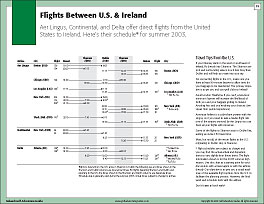 Make air travel reservations (pp. 18-19). I now know our desired arrival and departure dates from the planning calendar and use those to book flights. I see (p. 19) that Continental has direct flights between Newark (EWR) and Shannon (SNN). From the PDF version of the guide, I link directly to Continental’s web site and book the flight.
Make air travel reservations (pp. 18-19). I now know our desired arrival and departure dates from the planning calendar and use those to book flights. I see (p. 19) that Continental has direct flights between Newark (EWR) and Shannon (SNN). From the PDF version of the guide, I link directly to Continental’s web site and book the flight.
Make the tee times (p. 2). I call the courses myself before 5pm Ireland time, which is noon EST (p. 33), and get the tee times. Alternatively, I could have had SWING (p. 31) do it, but making a tee time in Ireland is really no harder than calling a local course. A few of our courses want fax confirmations and deposits, so I do that with the fax cover page (faxcover_letter.doc) that comes with the guide. Everything has worked out as planned, so we now need places to stay.
Book accommodations. I look up Tralee (p. 28) in the Accommodations section and pick the Grand Hotel because its the least expensive one (I’m frugal). I’m online so I click on the weblink in the guide PDF and check out the hotel’s web site. Looks good to me. I call them up and book two rooms (sharing) for the nights of June 11-13. In Lahinch (p. 26) I go for the Atlantic Hotel. It’s right on the main street in town, which is what we like. I call them up directly and book two rooms for the nights of June 14-16. It’s less than a one-hour drive (p. 8) from Lahinch to Shannon airport so there should be no problem getting there for our Saturday morning (11:20am) departure flight. I book the rooms directly myself; it’s just a lot easier than fussing with web-based systems and when I’m done I know for sure that the reservation has been made.
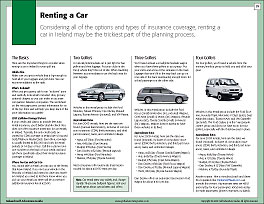 Rent a car. Since there are four golfers, it looks like were going to need a minivan/minibus (p. 29). I normally rent from Avis so I check them out first and get a quote, noting all of the options on the worksheet (p. 30). I then checked out Argus and Dan Dooley for their quotes. After comparing it all, I rented from one of them.
Rent a car. Since there are four golfers, it looks like were going to need a minivan/minibus (p. 29). I normally rent from Avis so I check them out first and get a quote, noting all of the options on the worksheet (p. 30). I then checked out Argus and Dan Dooley for their quotes. After comparing it all, I rented from one of them.
* I could have had my travel agent do this step.
Take the trip. I take along parts of the guide in a clear plastic envelope which also holds the Collins road map. Along the way it can be used to gather score cards, brochures, etc. It’s great that I don’t have to lug around an entire guide book; I just take the pages I need, which is much lighter and more compact. There are some good tips in the Practical Matters section (pp. 32-33) that help me bring the right electrical plug adapter and decide to not bother with travelers checks this time. During the trip, we consult the Golf Courses (pp. 10-15) and Driving Times (p. 8) sections to get directions to the course and determine when to leave the hotel so we arrive at least 30 minutes before our tee time. It’s nice to have all of this information with us.
Estimated Price Per Person
| Airfare |
$609. |
Continental Airlines round trip between Newark and Shannon |
| Green Fees |
$ 220.
85.
195.
240.
200. |
Tralee (€170)
Dingle (€65)
Ballybunion Old (€150)
Doonbeg (€185)
Lahinch (€155) |
| Hotel |
$ 234.
253. |
Grand Hotel (Tralee) assuming 60 per person sharing (three nights)
Atlantic Hotel (Lahinch) assuming 65 per person sharing (three nights) |
| Rental Car |
210. |
Assuming 7 days at $120 per day split evenly four ways. |
| Total |
$ 2,246. |
Per golfer, not including food, beverages, tips, caddies (June 7-14 2007) |
All of the information and tools you’ll need to build a great itinerary for your Ireland (Ireland Golf Adventure Guide) and/or Scotland (Scotland Golf Adventure Guide) golf trips are available from Golf Adventure Guides.
* I didn’t actually contact the courses, hotels, or car rental companies during the writing of this particular example, nor do I normally rent from nor necessarily endorse Avis. This is a hypothetical example.
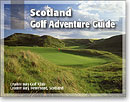 The Scotland Golf Adventure Guide has been updated for 2007-08. All new purchases (immediate download and printed) will receive the updated version effective immediately. Customers who have purchased a previous version of the guide can download a free update to this latest version. This is just one of the many advantages of purchasing one of my guides.
The Scotland Golf Adventure Guide has been updated for 2007-08. All new purchases (immediate download and printed) will receive the updated version effective immediately. Customers who have purchased a previous version of the guide can download a free update to this latest version. This is just one of the many advantages of purchasing one of my guides.
Updated information includes, but is not limited to:
- Green fees
- Golf course contact info (email, web sites, etc.)
- Accommodation contact info (email, web sites, etc.)
- Flight schedules
If you buy a travel guide book that was printed sometime last year, or you already own one, I can guarantee that a good portion of the information in it is out of date and/or incorrect. By publishing my guides electronically, I can easily deliver you the latest — and most correct — information. And, even after you’ve made a purchase, because you get free updates you’ll always have access to accurate information when you plan your next trip.
Why would anyone publish and purchase any other way?
Come on, admit it. You’ve been thinking about taking that “once in a lifetime” golf trip to Scotland with a few of your buddies. Now is the time to take the first step towards making it a reality. Best of all, it’s free. Go to VisitScotland.com and request a free copy of their The Official Guide to Golf in Scotland 2007 brochure.
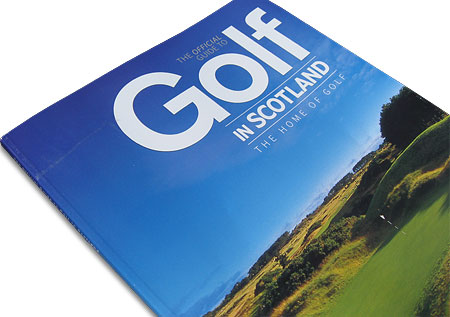
Their brochure — more like a catalog really — is chock full of great photographs, maps, course listings, accommodations, etc. I think it will get you pumped up to plan a golf trip to Scotland. Actually, it has too much information. That’s where Golf Adventure Guides comes in. My Scotland Golf Adventure Guide will help you cut through the clutter and give you the practical tools to make your trip-planning process easy and enjoyable.
Take that first step today and order their 2007 brochure. Then, when you’re ready to plan your trip, come on back here and check out my Scotland Golf Adventure Guide. Now, off you go!
The Ireland Golf Adventure Guide has been updated for 2007-08. All new purchases (immediate download and printed) will receive the updated version effective immediately. Customers who have purchased a previous version of the guide can download a free update to this latest version. This is just one of the many advantages of purchasing one of my guides.
Updated information includes, but is not limited to:
- Green fees
- Golf course contact info (email, web sites, etc.)
- Accommodation contact info (email, web sites, etc.)
- Flight schedules
If you buy a travel guide book that was printed sometime last year, or you already own one, I can guarantee that a good portion of the information in it is out of date and/or incorrect. By publishing my guides electronically, I can easily deliver you the latest — and most correct — information. And, even after you’ve made a purchase, because you get free updates you’ll always have access to accurate information when you plan your next trip.
Why would anyone publish and purchase any other way? The 2007-08 for the Scotland Golf Adventure Guide is in the works…
This article is from the December 1908 issue of The American Golfer and is “A Critical Description of the Characteristics and Qualities” of St Andrews. Prices and yardages have changed a bit since then.
Golfers who have not been to St. Andrews are often sceptical about the praises they have heard sung to its glorification. They cannot bring themselves to believe entirely that any golfing place is quite so charming or that any course is quite so good architecturally and for the enjoyment that it affords to the capable player as are St. Andrews and its old links. I will consider, then, that at the outset I am abruptly interrogated by my readers on these points, and I answer that I can conceive of the true golfer deriving no greater pleasure than in living awhile in this ancient corner of Fifeshire, and that, provided he knows the game and can play the different shots as they ought to be played, golf on this old course is a supreme intellectual and physical enjoyment. The course has certain minor faults, but the best golfing opinion is generally to the effect that it is superior to any other in Britain.
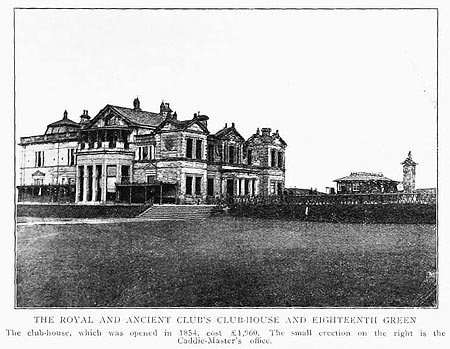
Well then, what is the charm of St. Andrews? When the golfing man visits it for the first time, and, after a wearisome journey, travels on the last bit of railway from Leuchars function, and presently, feeling the brakes go on, he looks through the windows of his carriage on the seaward side and sees the players driving to some of the homeward holes–the 14th, 15th and 16th–he usually feels something of a thrill, a kind of spiritual ecstacy as of the pilgrim after many wanderings reaching his Mecca at last.
Then in the first brief hours of his sojourn he appears to be inhaling an atmosphere of golf, and to be living in a City of Golf as never before. Here at St. Andrews the industry is golf, the people talk of it and of little besides, largely they live on it, men and boys spend their working hours on the links, there are foundries, warehouses, shops, hotels–all for this game of golf. And in the public places, as if it were to cap this impression of the supreme importance of the game over all other things, the player may see what he will in no other town in the world–official printed notices invested with all the authority of the police and the law stating that golfers are forbidden to play on the course with iron clubs only (for the sake of the tees and the fairway) and that offenders are liable to be fined twenty shillings and costs at the police courts or, in the alternative, to be sent to gaol (jail) for a month! The Corporation is given these powers because the links is town property and for the benefit of the town. It is a matter of interest to add that a little while since a personage of no less importance than the Prime Minister, Mr. Asquith, who is a keen golfer, went out to play at St. Andrews with no wood in his bag and was duly “pulled up” under this law. In the same way, it is a punishable offence to practice putting on the 18th green. These notices are prominently displayed outside the police station, in the post offices, in the hotels and other public places. Mention of such small matters serves to show that St. Andrews is really not at all like other golfing resorts, and visitors to it feel that very soon after their arrival.
Yet it sometimes happens that, after the first day or two, there is some small sense of disappointment, and at this period this may also be the feeling in regard to the quality of the course. The plain fact of the matter is that both need to be known well to be appreciated properly, and it has been almost the invariable experience that people who have cared little or nothing for St. Andrews at the end of their first visit, have liked it better the second time, and that on the third or fourth they have developed a passion for it which has prevented them from keeping away afterwards for more than a few months at a time. They feel that they have found their natural home at last, and life and the game seem stronger things than ever they were before.
This preamble will have done something to give strangers some idea of the charm of St. Andrews as a golfing resort, and how it comes to be what we would call an acquired taste. The strangers are at the outset a little overcome and awestricken by the vast traditions of the place, the knowledge that golf has certainly been played here for about four hundred years, that it was on this old course that the great captains of golf of the ancient days, like St. Clair of Roslin, played their game, and that in later times giants of the game like Allan Robertson and the Morrises, father and son, and–still later–that hero among amateurs, the late Lieut. F. G. Tait, played most and loved most to play. But veneration of this kind is sometimes a fleeting thing, and then the golfer visitor comes to reckon up St. Andrews severely on its golfing merits and in the end is satisfied.
Then in what does the quality of St. Andrews chiefly consist? In the first place, there is not a really bad hole on the course. There may be one or two which are not of great excellence, but in hardly any case can the player take the hole in the par figure, or one less with a long putt, without playing good and proper golf. Above everything, St. Andrews is a course for golfers to think hard when playing it. Every shot has to be considered with the utmost care; and it is especially the case that with tee shots and long seconds the line has to be carefully decided on and then taken almost to a nicety, otherwise, even if a bunker is avoided, the succeeding stroke is rendered enormously difficult. In many respects there seems to be a positively devilish cunning in the course. There is generally an easy and most enticing way of playing the shot in hand, but it happens just as often that if that way is adopted the player has very much extra to do with the next one. Thus, in a general way there is plenty of room on the left when playing from the tee, while the way to the right seems to bristle with hazards and other dangers. The result of this is, as some say, that St. Andrews golfers have come to be a race of pullers; but that is rather a reflection on their capacity. The man who is not sure with his wooden clubs, and cannot command direction as he would like, goes to the left for safety and takes his chance about what he will get for the next shot. But, though the way to the right is so well guarded, there is plenty of room for the accurate player, and if he can get a safe line that way he is well rewarded by an easy passage to the hole afterwards. Thus we have one way for courage and skill and another for fear and lesser ability, and it does not seldom happen that when these elements are opposed to each other the keeper of the latter set is struggling for his half all the time.
These circumstances are brought about partly by the conformation of the ground, which is surely the finest on earth for golfing and seems almost to have been designed by Providence for the purpose, and partly by the judicious manner in which the innumerable pot bunkers have been placed. They have not been put where they now are as the result of the deliberations of a committee during a few months, but as the result of the aggregation of experience of the best players, theorists and critics during generations. And in this matter the course is now appreciably more difficult than it was a few years since. One decade back it was at its easiest, the whins and rough that made trouble in the olden days having been trodden away by thousands and thousands of players. Something had to be done to make up for this, and when the rubber ball came in and absurdly low scores were being made on courses everywhere, the authorities at St. Andrews determined that it was the time for action, and consequently in the winter of 1904-5 a large number of new bunkers were cut. The result was seen in the fact that whereas in 1900 J. H. Taylor won the Open Championship there with a score of 309 for the four rounds done with the gutty ball, in 1905 James Braid took 318 strokes with the rubber ball and even then won the championship with a good margin over the next man. At that time there were many complaints that some of the new bunkers were unfair, that they were hardly to be seen, and that, being sometimes small and deep, they were too difficult to get out of. But time has softened the feelings of resentment against them, and it is realized that they make for judgment and accuracy. The course, as Mr. John Low points out, is not one that tests the exceptionally long driver who carries over everything, so much as the ordinarily long driver. This latter man must place his tee shot, and one of the first things he has to realize is that his proper line is not always the straight one to the hole. Thus, at the 9th hole there is a bunker right in the middle of the course just at the distance of a quite first-class drive. Some say, then, that that is unfair; but the answer of St. Andrews is that the bunker is there to be avoided, and if you are going to drive that distance you must make up your mind which side of the bunker you are going to drive to. It might just be added that the predominant bunker is the small pot. There are a few huge bunkers like the Hades, met with in going to the 14th, but the cross or ribbon bunker, such as is common on many other courses often reckoned in the first-class, is conspicuous by its absence. From this it almost follows that mere carries from the tee, irrespective of direction, are rarities.
These remarks have reference chiefly to the long game; but corresponding difficulties are met with in the short one. To approach the hole properly with an iron club, it is not enough to play a shot well, but the shot must be played, and thoroughly, if the best results are to be achieved. Most of the greens are on plateaus which in itself makes for thought and difficulty: but the feature of the course, so far as the short game is concerned, is that the bunkers protecting the greens are most dreadfully close in–not merely to the green but to the hole itself, sometimes being within four or five yards of it. Having to approach to a plateau green with the knowledge that only about that distance beyond the pin is a wretched little pot is about as much of a test of the nerve and skill of the operating golfer as he need wish for. Knowing his course, what he does in this case, if he can, is to play his previous shot so that he places that aforesaid bunker out of the line of his approach.
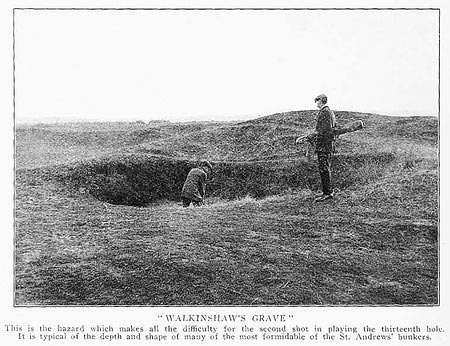
Thus in one way and another each shot to a hole bears so very directly on the others as is the case on no other course, and. as Mr. Low puts it, “the playing of the hole thus becomes not a series of isolated shots with no bearing the one on the others, but each stroke has to be played in relation to the following one, and the hole mastered by a preconceived plan of action.” Surely this is not only interesting golf, but good golf in the best sense, and that is why we regard St. Andrews as the supreme test of a player.
And now from the general to the particular, in the way of a glance round the links, making note here and there of special features. After the first hole the course goes round nearly to right angles, and out at the end (here is a long hook on it, and there is a crossing in one place, a circumstance which has sometimes led to accident, as at the autumn meeting last September, when a personage of no less consequence than Mr. A. J. Balfour, the ex-Prime Minister, was struck violently on the head with the ball of another competitor, just as he was about to putt at the second short hole. The line of the course (as will be gathered from the plan that is presented and which will explain many points in the architecture and bunkering) makes it that winds of all kinds have to be encountered. The first hole looks a simple thing, just requiring a cleek or iron for the second at most times; but the Swilcan Burn, out of which it is next to impossible to play and from which the ball is generally lifted under penalty, is close up to the green, and has been the ruination at the outset of hundreds of what would otherwise have been excellent rounds. This hole becomes a particular terror when it is not the 1st but the 19th, as in the case of ties in the matches for the Amateur Championship, and it made a big piece of history, among other occasions, in 1895, when the event mentioned was played at St. Andrews. At that time Mr. John Ball, who had already won the championship four times and was then the holder of the distinction, was just at the height of his powers, and it was his clearest ambition to win the championship once at the traditional Scottish home of the game, which no Englishman had ever done. He ran through to the final, where he met Mr. Leslie Balfour Melville, and this pair tied (the final was then an 18-hole affair) and had to go on to the 19th. Both played short of the Burn with their seconds, and then Mr. Ball, for about the only time in his life in such circumstances, seemed to get scared. He hesitated, and finally determined to use a mashie that he had not had out of his bag for some days. With this stranger he put the ball into the water and lost the championship. It took him twelve years to make up for that mistake, but at last, in 1907, he did win the championship at St. Andrews, and it was a curious coincidence that Mr. Balfour Melville was then the captain of the Royal and Ancient Club and had the pleasure of handing the Cup and gold medal to the hero of the meeting.
The second is a fine two-shot hole, and the tee shot has to be played to the left or to the right according as to whether the wind is for or against. The green is small, and is clustered with bunkers all round so that the second shot has to be a marvel of accuracy. The third hole is a gem of the drive-and-iron class. Here is an instance where a pulled ball gets the player into a dreadful difficulty with his approach. The fourth hole is another two-shotter, and special interest is given to the approach by the fact that there is a knoll sticking up out of the fairway just in front of the green. The fifth is the “long-hole out,” and is a good 5 at any time, though you do sometimes see some of the big hitters like Mr. Edward Blackwell using a mashie for their second when they have a high wind behind them. Mr. Blackwell, who for long has enjoyed the reputation of being the longest driver in the country, here performed, some sixteen years ago, perhaps his most wonderful feat in this department. He reached the green in two shots–with the gutty ball of course–and then, as he and his partner only intended playing a few holes, they turned round and played the same hole in, as it may be done, the course being so laid out that it is sometimes played in the reverse direction. Again he reached the green in two shots, so that whichever way the wind was its effects were balanced, and in four shots the player drove over a thousand yards. The hole here is cut on what is probably the largest green in the world, serving for the thirteenth as well; and if the player
 Recently, a few friends and I set out for a great golf adventure in Ireland. For two weeks we played golf daily at one of the many fine links courses, enjoyed the wonderful Irish hospitality every step of the way, and drank plenty of “the black stuff” to keep up our strength.
Recently, a few friends and I set out for a great golf adventure in Ireland. For two weeks we played golf daily at one of the many fine links courses, enjoyed the wonderful Irish hospitality every step of the way, and drank plenty of “the black stuff” to keep up our strength.
One of the lads, a talented songwriter who runs his own music publishing company, was inspired to capture the spirit of the trip in song. To celebrate this Ireland Golf Adventure Scott Johnson wrote “Golf — It’s What Guinness Is Fore!” (see lyrics below). You can listen to an MP3 version of the song below and purchase the MP3 file at Googol Press.
[audio:http://googolpress.com/media/l12.mp3]
Golf — It’s What Guinness Is Fore!
With clubs in our bags and balls in our hands
We began our adventure in old Ireland
We were three buddies footloose and free
With dreams of great golf on the links by the sea
The courses were gorgeous like a young Irish lass
But looks can deceive like tall, rough, green grass
With our first round it was made all too clear
Why all the locals drank so much beer
Chorus
Golf — it’s what Guinness is fore
Please won’t you pour us one more
We’ve lost all our balls
Now we’re stuck with our scores
Golf — it’s what Guinness is fore!
We’d start off each mornin’ sayin’ this is the day
That the old Irish course would submit to our play
But by the round’s end we’d leave in defeat
And off to the pub we would retreat
Chorus
From Dublin to Baltray, Lahinch and Tralee
To Sligo and Doonbeg and places between
We hooked and we sliced and we shanked quite a few
For this game is illusive but one thing is true
Chorus
Lyrics and music by Scott Johnson


 Start building the rough itinerary (p. 6). We only have five days, so I want to minimize driving. Looking at the Driving Times & Distances map (p. 8) and Golf Courses & Towns Map (p. 9) I see that the southwest area is good. The Getting to Ireland section (pp. 18-19 are relevant to travellers from the U.S.) recommends flying into Shannon. I’ll figure out where to stay later.
Start building the rough itinerary (p. 6). We only have five days, so I want to minimize driving. Looking at the Driving Times & Distances map (p. 8) and Golf Courses & Towns Map (p. 9) I see that the southwest area is good. The Getting to Ireland section (pp. 18-19 are relevant to travellers from the U.S.) recommends flying into Shannon. I’ll figure out where to stay later. Transfer to the calendar (p. 6) Using the Course Cards (card_irl200x.pdf), I see that the only course in this list with visitor-policy issues is Tralee. Looking at the detailed visitor policy (p. 15) for Tralee confirms it–no visitors Sunday (all year) or Wednesday (June, July, August). That means we could play our first round in Tralee on a Monday. Looking at the calendar (calendar_irl2007.pdf) for June, I see that Monday, June 5th is a bank holiday and most likely won’t allow visitors (holidays are treated like Sundays). We want to fly on the weekend, so let’s start the trip with the first day of golf at Tralee on June 12th. I write out the courses on the calendar (I print out just page 6 to save paper) and the arrival and departure dates fall out. From the calendar:
Transfer to the calendar (p. 6) Using the Course Cards (card_irl200x.pdf), I see that the only course in this list with visitor-policy issues is Tralee. Looking at the detailed visitor policy (p. 15) for Tralee confirms it–no visitors Sunday (all year) or Wednesday (June, July, August). That means we could play our first round in Tralee on a Monday. Looking at the calendar (calendar_irl2007.pdf) for June, I see that Monday, June 5th is a bank holiday and most likely won’t allow visitors (holidays are treated like Sundays). We want to fly on the weekend, so let’s start the trip with the first day of golf at Tralee on June 12th. I write out the courses on the calendar (I print out just page 6 to save paper) and the arrival and departure dates fall out. From the calendar: Make air travel reservations (pp. 18-19). I now know our desired arrival and departure dates from the planning calendar and use those to book flights. I see (p. 19) that Continental has direct flights between Newark (EWR) and Shannon (SNN). From the PDF version of the guide, I link directly to Continental’s web site and book the flight.
Make air travel reservations (pp. 18-19). I now know our desired arrival and departure dates from the planning calendar and use those to book flights. I see (p. 19) that Continental has direct flights between Newark (EWR) and Shannon (SNN). From the PDF version of the guide, I link directly to Continental’s web site and book the flight. Rent a car. Since there are four golfers, it looks like were going to need a minivan/minibus (p. 29). I normally rent from Avis so I check them out first and get a quote, noting all of the options on the worksheet (p. 30). I then checked out Argus and Dan Dooley for their quotes. After comparing it all, I rented from one of them.
Rent a car. Since there are four golfers, it looks like were going to need a minivan/minibus (p. 29). I normally rent from Avis so I check them out first and get a quote, noting all of the options on the worksheet (p. 30). I then checked out Argus and Dan Dooley for their quotes. After comparing it all, I rented from one of them. The
The 


 Recently, a few friends and I set out for a great golf adventure in Ireland. For two weeks we played golf daily at one of the many fine links courses, enjoyed the wonderful Irish hospitality every step of the way, and drank plenty of “the black stuff” to keep up our strength.
Recently, a few friends and I set out for a great golf adventure in Ireland. For two weeks we played golf daily at one of the many fine links courses, enjoyed the wonderful Irish hospitality every step of the way, and drank plenty of “the black stuff” to keep up our strength.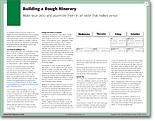 An itinerary is not just a list of courses to be played. You must assemble them in chronological order and in a sequence that works geographically. Course visitor policies and holidays influence which days of the week you can play a particular course. The sequence is influenced by the driving times and distances between the courses and towns in which you
An itinerary is not just a list of courses to be played. You must assemble them in chronological order and in a sequence that works geographically. Course visitor policies and holidays influence which days of the week you can play a particular course. The sequence is influenced by the driving times and distances between the courses and towns in which you